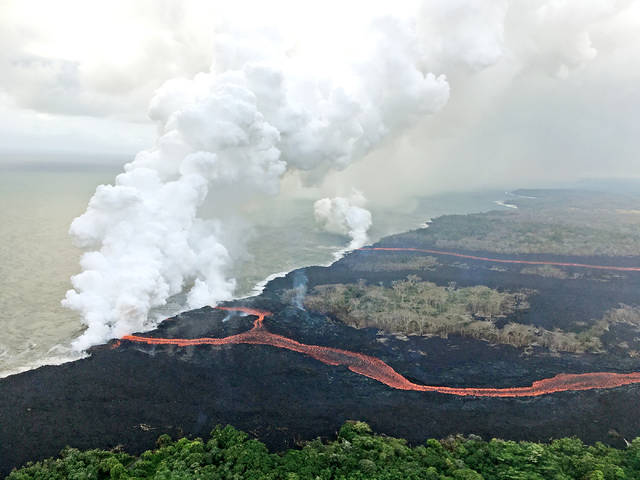Three weeks into the lower Puna eruption, volcanic activity remains high but stable along Kilauea’s East Rift Zone.
“There’s no indication the volume of what’s coming out of the ground will increase or decrease right now,” said Wendy Stovall, a U.S. Geological Survey volcanologist.
“It seems like a steady state up there and at the summit, too.”
Copious amounts of lava continued to pour out of fissures Thursday from Leilani Estates through Lanipuna Gardens to the northeast, with at least two rivers of lava entering the ocean to the south. The ocean entries are located between Pohoiki and MacKenzie beach parks and have covered a portion of Highway 137.
Since its start May 3, the lower Puna eruption has destroyed about 50 structures and covered more than 1,700 acres. About 2,000 people have been evacuated, mainly in Leilani and Lanipuna, both located on the rift zone.
Kilauea has been erupting almost continuously for 35 years. Between January 1983 and January 2018, lava destroyed 215 structures, mostly in Kalapana or the former Royal Gardens subdivision, and covered 56 square miles.
At the summit, numerous ash plumes continue to be emitted. One plume reached 10,000 feet above sea level Thursday evening. Hawaii Volcanoes National Park remains closed.
Ash has been falling over communities in Ka‘u, and a special weather statement remains in place over that district.
The majority of the park had been closed for 14 days as of Thursday, said spokeswoman Jessica Ferracane. Only the Kahuku unit near Ocean View remains open. The closure began due to increased seismic activity and threat of explosive eruptions.
She said no employees have been laid off, and staff are working as much as they can from home or other locations. Crews also are continuing to make repairs to water lines and other infrastructure damaged by recent earthquakes.
The closure of one of Hawaii Island’s major attractions is costing the overall economy. Ferracane estimated the island has lost $6.5 million so far, based on a 2017 park economic impact study.
In 2013, the park closed for 16 days due to a shutdown of the federal government.
In lower Puna, lava had not progressed any closer toward the geothermal wells at Puna Geothermal Venture.
Jim Kauahikaua, a Hawaiian Volcano Observatory geophysicist, noted that the minimal seismic activity on the rift zone shows that the magma intrusion in the area is stable.
“The intrusion is not expanding the rift zone anymore,” he said. “And that just means that the rocks that the intrusion has pushed into are now elastically relaxed around it.
“There’s no more deformation (at the rift zone). At the summit, it’s still deflating or still subsiding.”
Kauahikaua said heat continues to be detected under steel plates placed over ground cracks on Highway 130 between Leilani and Kalapana. The cracks, some of which are emitting steam, were noticed a few weeks ago in an area where the highway crosses the rift zone.
He said he doesn’t know if the heat level is increasing at all, and the cracks still don’t appear to be emitting sulfur dioxide, which could indicate an eruption.
But officials aren’t
ruling out the possibility of a fissure forming there.
Tim Sakahara, state Department of Transportation spokesman, said the metal plates are holding up.
“We are aware that conditions can change at any moment’s notice,” he said.
But DOT plans to keep that highway, a lifeline for residents, open as long as possible. Contingency plans include filling cracks or adding additional heat-resistant plates.
“Fortunately, at this point, we haven’t had to use those in addition to the steel plates,” Sakahara said. “We are working toward that end.”
A community meeting on the eruption will be held at 5:30 p.m. Tuesday at Pahoa High School.
Hawaii County said in a news release that bus route No. 3 to Pahoa will be reinstated today. No bus routes are available to Pohoiki, Seaview or Leilani.
To view the latest lava map, visit www.hawaiicounty.gov/2018-lava-map.
Email Tom Callis at tcallis@hawaiitribune-herald.com.






